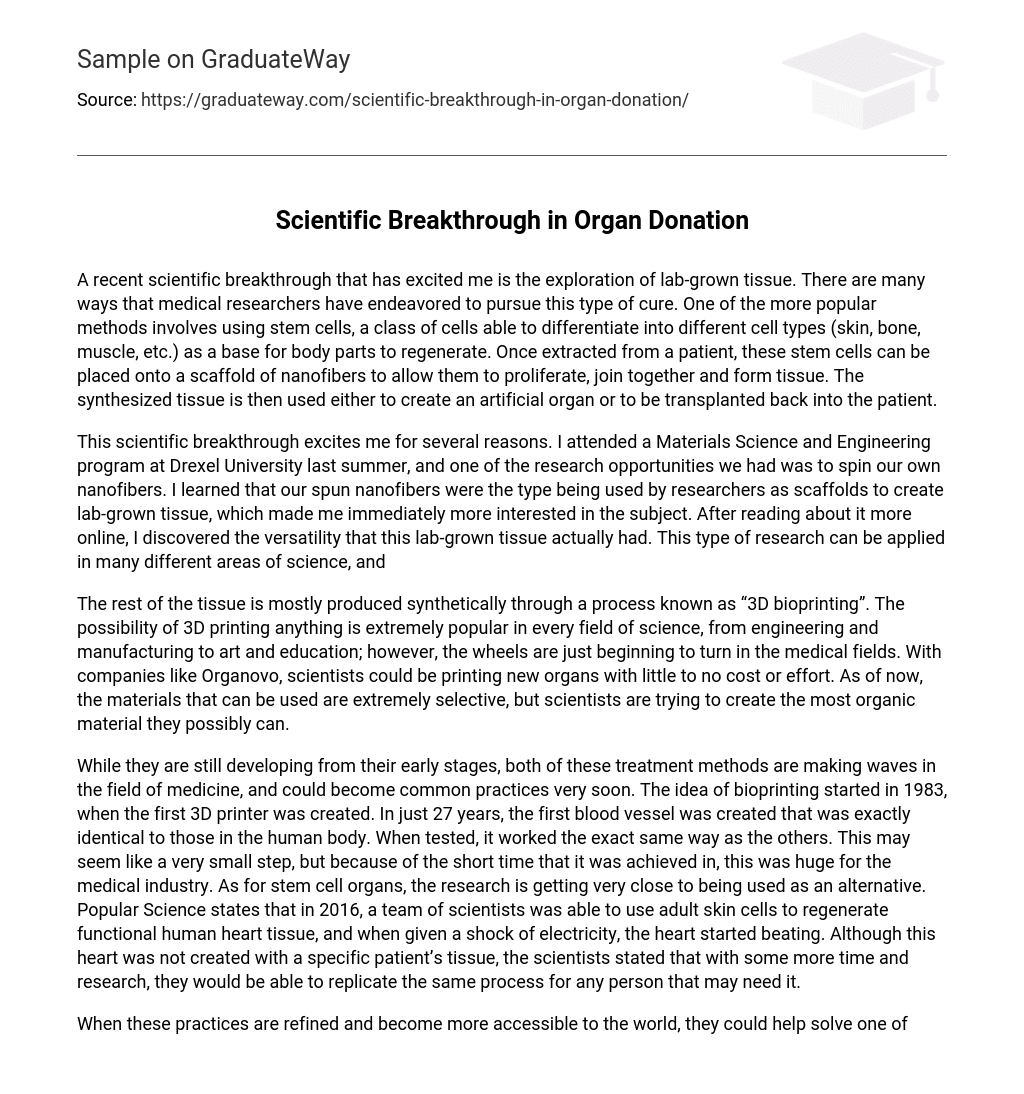A recent scientific breakthrough that has excited me is the exploration of lab-grown tissue. There are many ways that medical researchers have endeavored to pursue this type of cure. One of the more popular methods involves using stem cells, a class of cells able to differentiate into different cell types (skin, bone, muscle, etc.) as a base for body parts to regenerate. Once extracted from a patient, these stem cells can be placed onto a scaffold of nanofibers to allow them to proliferate, join together and form tissue. The synthesized tissue is then used either to create an artificial organ or to be transplanted back into the patient.
This scientific breakthrough excites me for several reasons. I attended a Materials Science and Engineering program at Drexel University last summer, and one of the research opportunities we had was to spin our own nanofibers. I learned that our spun nanofibers were the type being used by researchers as scaffolds to create lab-grown tissue, which made me immediately more interested in the subject. After reading about it more online, I discovered the versatility that this lab-grown tissue actually had. This type of research can be applied in many different areas of science, and
The rest of the tissue is mostly produced synthetically through a process known as “3D bioprinting”. The possibility of 3D printing anything is extremely popular in every field of science, from engineering and manufacturing to art and education; however, the wheels are just beginning to turn in the medical fields. With companies like Organovo, scientists could be printing new organs with little to no cost or effort. As of now, the materials that can be used are extremely selective, but scientists are trying to create the most organic material they possibly can.
While they are still developing from their early stages, both of these treatment methods are making waves in the field of medicine, and could become common practices very soon. The idea of bioprinting started in 1983, when the first 3D printer was created. In just 27 years, the first blood vessel was created that was exactly identical to those in the human body. When tested, it worked the exact same way as the others. This may seem like a very small step, but because of the short time that it was achieved in, this was huge for the medical industry. As for stem cell organs, the research is getting very close to being used as an alternative. Popular Science states that in 2016, a team of scientists was able to use adult skin cells to regenerate functional human heart tissue, and when given a shock of electricity, the heart started beating. Although this heart was not created with a specific patient’s tissue, the scientists stated that with some more time and research, they would be able to replicate the same process for any person that may need it.
When these practices are refined and become more accessible to the world, they could help solve one of the major problems in medicine: organ donation. Today, there are many more people waiting on the transplant list than ever before, and this is leading to many problems. Over the past 10 years, transplant recipients have more than tripled the amount of donors. There just simply are not enough donors to compensate for everyone waiting for their lives to be changed. That crisis called for something to be done, and that was when new methods of giving people organs started being created and shared with the world. Now that the tissue for these organs can be created in a lab setting, the organ transplant process should be expedited and shorten the transplant list significantly.
Lab-grown tissue can be used for much more than just transplants as well. Organs created with these tissues could be implemented to test the effects of a medicine on certain body parts. This would be the most accurate way to experiment with these drugs without the need for a test subject. It can also be applied in food science, where researchers are finding ways to produce lab-grown meat as an alternative to real animal meat. This would eliminate certain vegetarian and vegan restrictions about killing animals for food, allowing a greater population to have a more balanced and free diet.
The creation of lab-grown tissue, which was once best left to science fiction, is now becoming reality, and many scientists are trying to figure out how this breakthrough could help them in their respective fields. Researchers are getting very close to making these options available throughout humanity, and as soon as the research is ready, it will hopefully be shot out to the general public like a bullet and take the world by storm.





